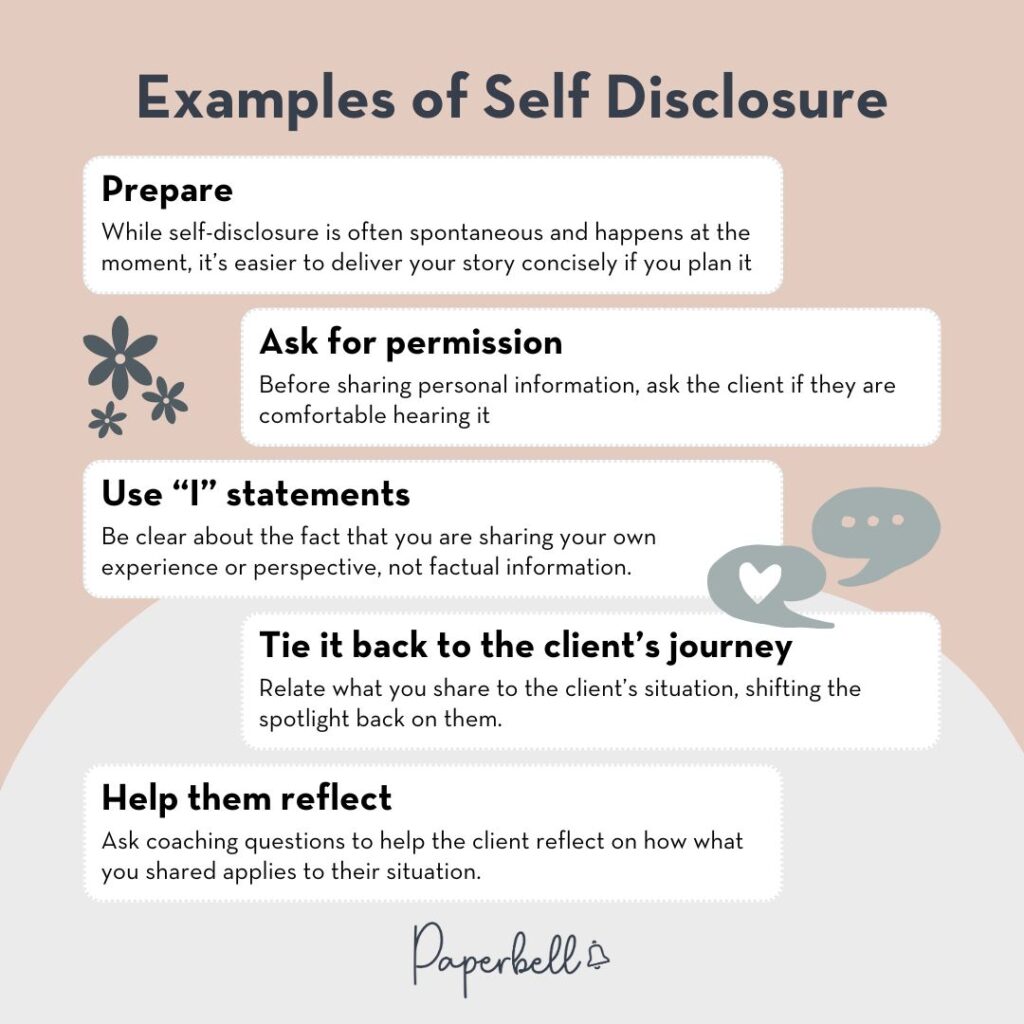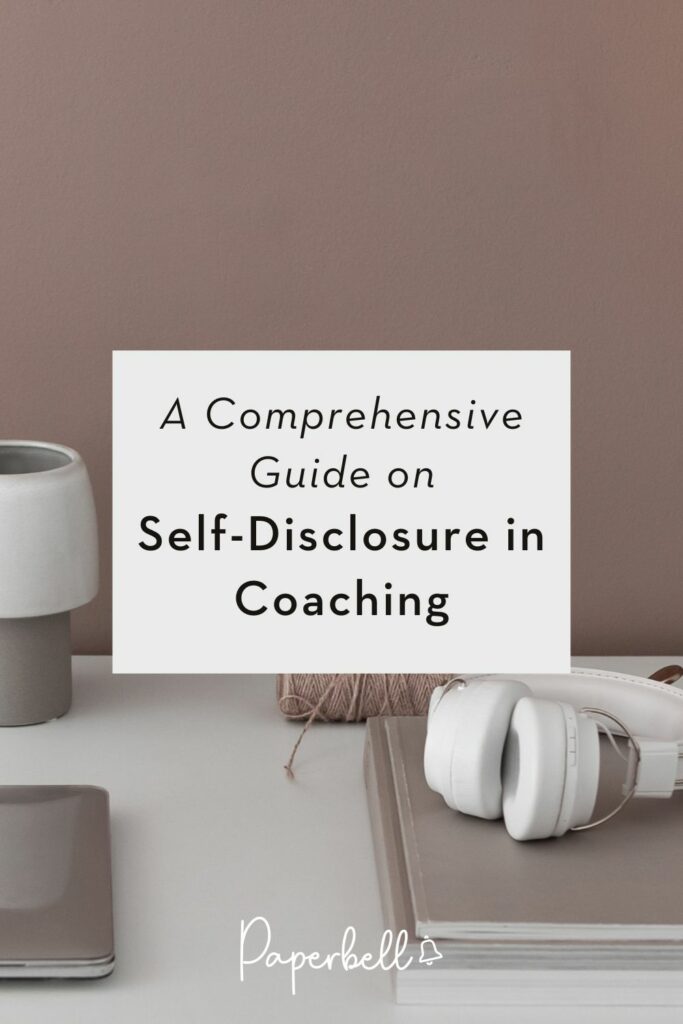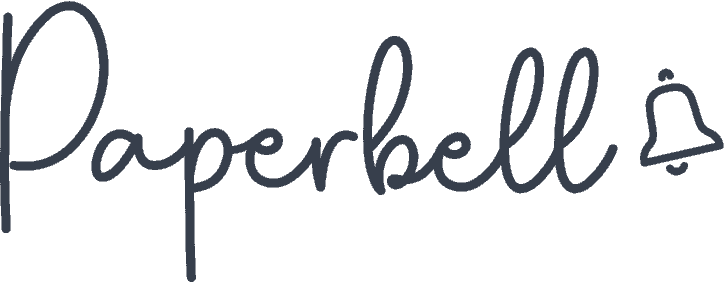You’re in the middle of a coaching session when your client shares a struggle that mirrors your own past experience. That familiar pull to share your story bubbles up—but should you?
Self-disclosure in coaching walks a delicate line. Share too much and you might hijack the session; share nothing and you could miss an opportunity to deepen trust and connection.
Let’s explore the art of opening up to clients: when personal stories enhance the coaching relationship, when they derail progress, and how to share in ways that keep the focus where it belongs—on your client’s transformation.
What is Self-Disclosure in Coaching?
The American Psychological Association (APA) defines self-disclosure as revealing personal or private information about oneself to others. Sharing thoughts, experiences, and feelings can create closeness and intimacy between people.
[ Read: The Life Coach Encyclopedia: 60 Coaching Terms That Every Coach Should Know ]
We may share information about ourselves voluntarily or involuntarily, verbally or nonverbally. Different social contexts, from the workplace to social media or our close relationships, require other forms of self-disclosure.
While self-disclosure in everyday life is complex and doesn’t follow a consensus of right or wrong ways, it’s much more outlined in the context of coaching and counseling. Let’s break down what it looks like in sessions.
The Purposes of Self-Disclosure in Coaching
When your client shares something strikingly similar to your experience, you may empathize with them deeply and feel the urge to share your story.
Personal anecdotes can often contribute to the client’s growth. Still, there’s a fine line between sharing and oversharing—especially in coaching, where the focus always needs to remain on the client.
Telling the client about your experience usually serves one of these purposes:
Building Trust
Sharing personal experiences can demonstrate authenticity and openness, and as a result, it can help you build rapport with your client.
It can contribute to cultivating a safe space where sharing is okay. It makes the client feel accepted and heard.
Modeling Behavior
Self-disclosure can also show an example of vulnerability and self-acceptance to your client.
If they’ve never learned how to express their feelings, they may need to see someone else do it first. It might help them accept themselves without judgment and criticism and alter their inner dialogue.
Providing Perspective
Your experiences navigating similar situations or overcoming obstacles may help clients see their challenges and doubts differently.
The important thing is to take up only a little screen time, and when you do share, always tie your story back to the client and give them the spotlight.
Encouraging Self-Acceptance
Sometimes, letting clients know you’ve experienced the same challenges reaffirms that they are not alone with their problems. It normalizes their situation and weeds out feelings of shame or inadequacy.
Of course, telling your client about a similar experience should always be genuine and acknowledge that their story is unique to them.
Want to create that professional structure without the hassle? Paperbell helps you establish clear coaching boundaries from day one. With automated contracts, session scheduling, and client management, you can focus on the coaching relationship while our platform handles the professional framework. Try Paperbell free with your first client and see how the right tools make boundary-setting simple.
The Risks of Self-Disclosure
While potentially beneficial, self-disclosure in sessions also carries certain risks that coaches should be mindful of.
Shifting the Focus Away From the Client
Excessive self-disclosure may lead to a shift in focus away from the client’s needs and goals. If the coach shares too much personal information, the client may perceive it as a sign of their inability to help them effectively.
It may also convey a lack of interest in the client’s issues and needs, undermining trust in the coaching relationship.
Blurring Professional Boundaries
Sharing inappropriately or too much can blur the boundaries in the coaching relationship. Clients may view the coach more as a friend than a professional.
It can undermine their progress and the coach’s ability to maintain an objective perspective.
Influencing the Client
If the coach implicitly or explicitly shares their personal beliefs, they can bring bias into the coaching conversation. They may hijack the client’s thought process and decisions instead of giving them freedom with open-ended questions to explore their perspective.
What are the Different Types of Self-Disclosure?
In counseling, we can differentiate four different categories of self-disclose, which also apply to coaching.
Accidental
These are accidental revelations of personal information that occur outside sessions or through spontaneous reactions.
For instance, the coach or counselor might accidentally disclose personal details during a casual conversation or display specific non-verbal cues that reveal information.
Unavoidable
In contrast to accidental disclosures, unavoidable ones occur due to obvious distinguishing characteristics of the coach or counselor, such as their race, gender, attire, or other visible attributes.
Clients may glean personal information about them by observing these characteristics during sessions.
Client-Initiated
Clients may actively seek and obtain information about their coach’s or counselor’s personal life from external sources, such as their websites or social media profiles.
[ Download: FREE Template Pack for Coaches: Websites, Packages, and More ]
They might learn about their relationship status, lifestyle, or professional journey.
Deliberate
Deliberate self-disclosure happens when the coach or counselor purposefully shares personal information with the client during sessions.
Unlike the other categories, this is intentional and strategic, used to build trust and aid the coaching or counseling process—serving one of the purposes we’ve discussed above.
As a coach, you may intentionally share different information about yourself. These can be:
- Similar experiences you’ve encountered that may be relevant to the client’s journey
- Solutions that worked for you in the past with a similar problem
- Your own beliefs that may empower the client
It’s not just about deciding whether to share personal information about yourself with the client but also about deciding when.
It brings us to a crucial element of self-disclosure: timing.
Creating a Safe and Supportive Environment
When your coaching clients feel safe, they’re more likely to open up about what’s really going on.
Here’s how to create that environment:
- Set clear boundaries: Let clients know exactly what to expect from your sessions. When does the session start and end? What kind of support do you offer between sessions? Clear boundaries create predictability, which builds trust.
- Make them feel heard: Active listening goes a long way. Put your phone away, maintain eye contact, and tune in to your client’s words. Small nods and “I understand” moments show them you’re fully present.
- Keep it confidential: Be crystal clear about your confidentiality policy. When clients know their personal stories won’t end up as examples in your next newsletter, they can breathe easier and share more openly.
- Stay judgment-free: We all have opinions, but the coaching space isn’t where they belong. Practice holding space without letting your facial expressions betray your thoughts when a client shares something surprising.
- Encourage without pushing: There’s a fine line between encouraging clients to dig deeper and making them feel pressured. Use phrases like “Would you feel comfortable sharing more about that?” rather than “You need to tell me more.”
When you nail these elements, you create a coaching environment where transformation can truly happen. Your clients will feel the difference—and so will your practice.
When to Self-Disclose in Coaching?
Sidney Jourard was a humanistic psychologist who initiated some of the early studies on self-disclosure.
In an experiment, he asked members of a group to share about themselves in three different ways so he could divide them into the following categories:
- Minimal disclosure
- Early and extensive disclosure
- Gradual disclosure over time
Surprisingly, the group that was trusted the least was the one in which members shared a lot about themselves early on. On the other hand, the most trusted group was the one in which members disclosed gradually.
Rapid and excessive sharing can sometimes alienate others because self-disclosure is expected to be reciprocal, with individuals matching the other person’s disclosure level.
This is more complex in a coaching session where your client is expected to share a lot of personal information about themselves while you listen and frame the conversation around them.
Self-disclosure can help balance the conversation and create more trust. However, you’re still expected to maintain professional boundaries and keep the spotlight on the client for the majority of your time together.
Some questions that may help you decide when it’s time to share about yourself are:
- Does this information help the client in this particular situation?
- Is the client showing signs of openness to hearing my perspective?
- Will my story make the client feel less alone in their experience?
- Have I given them enough time to explore their own experience before I share mine?
- Are there other examples I can share that might be more helpful in this conversation?
- How much of the story do they need to hear now?
A coaching session isn’t the reciprocal conversation we’re used to in everyday life, but there’s another way to create trust between you and the client: through confidentiality.
A confidentiality clause should always be part of your agreements and communicated to the client. The clause ensures that what they share with you will never leave the session, so they may feel more comfortable disclosing intimate details of their lives without knowing yours.
[ Read: How to Write a Life Coaching Agreement in 6 Easy Steps ]
While most sessions should always focus on the client, your coaching style may also influence how much you talk about yourself.
For example, inspirational and motivational coaches often base their coaching process on personal experience. They usually attract clients who want to emulate the success and transformation they’ve achieved, so they might share more personal anecdotes to ignite passion and self-belief in the coachee.
In other cases, you should refrain from sharing your experience altogether, especially if you have fundamentally different beliefs, values, and circumstances than the client.
We’ve examined when self-disclosure is appropriate in a coaching session. Now, let’s break down how to do it.
What is a Good Example of Self-Disclosure?

Coaches must remain professional without being impersonal and distant in the coaching conversation. Here’s how you can share personal details about yourself, maintaining this delicate balance:
- Prepare: While self-disclosure is often spontaneous and happens at the moment, it’s easier to deliver your story concisely if you plan it.
- Ask for permission: Before sharing personal information, ask the client if they are comfortable hearing it.
- Use “I” statements: Be clear about the fact that you are sharing your own experience or perspective, not factual information.
- Tie it back to the client’s journey: Relate what you share to the client’s situation, shifting the spotlight back on them.
- Help them reflect: Ask coaching questions to help the client reflect on how what you shared applies to their situation.
Maria Katsarou, Clinical Psychologist and Professional Certified Coach, shares a great example of how she uses self-disclosure in her sessions.
When the client specifically asks her to share her experience, she answers: “I will share my journey; however, let’s look first at what it would look like for you.”
Then, she helps the client explore their perspective first, and eventually, she tells them about her own—explaining its unique context and circumstances.
Another great practice Katsarou suggests is sharing the stories of at least two other people. This way, the client has more perspectives to consider.
Cultural and Organizational Considerations
Self-disclosure doesn’t happen in a vacuum. It’s influenced by both cultural context and organizational settings.
Different cultures have varying comfort levels with personal sharing. In some cultures, opening up is seen as authentic and relationship-building, while in others, it might be viewed as unprofessional or inappropriate. As a coach, being sensitive to these cultural nuances helps you adapt your approach to better serve each client.
Organizational settings matter too. Your client’s workplace might have specific confidentiality expectations or professional boundaries. A coaching session with a corporate executive might require different self-disclosure choices than one with a solopreneur.
It’s important to be flexible. Pay attention to how your client responds when you share something personal. Do they lean in with interest or seem uncomfortable? These cues help you gauge how much sharing serves them in their specific cultural and organizational context.
Remember, the goal isn’t to follow rigid rules but to create the right environment where your client feels safe to explore and grow. Sometimes that means sharing from your experience, and sometimes it means stepping back to create more space for their story.
[ Read: Ethics in Coaching: How To Run a Business Without Losing Sleep at Night ]
Build the Coaching Practice of Your Dreams
Mastering the art of self-disclosure is just one part of becoming an exceptional coach who creates real transformation for clients. While you’re focused on developing these crucial coaching skills, let Paperbell handle the behind-the-scenes work of running your business.
With Paperbell, you’ll spend less time wrestling with scheduling tools, payment processors, and contract systems, and more time doing what matters most – coaching your clients to breakthrough results.
Our all-in-one platform gives you a professional coaching website with scheduling, payments, contracts, and client management seamlessly integrated. No tech headaches, just simplicity.
Try Paperbell for free with your first client and experience the freedom of a streamlined coaching practice.

Editor’s Note: This post was originally published in February 2023 and has since been updated for accuracy in March 2025.









